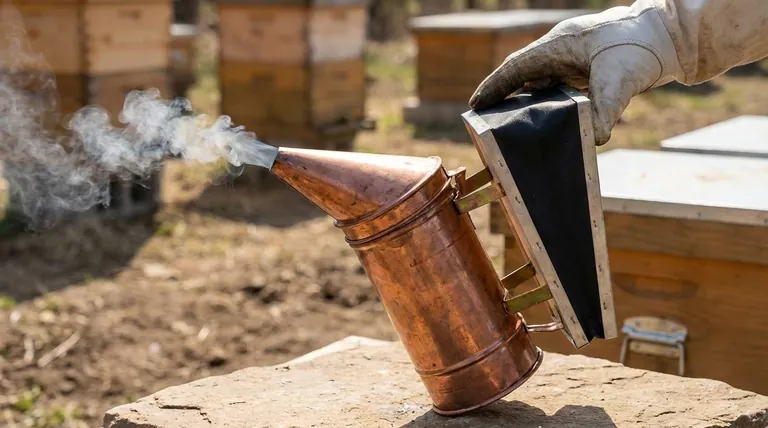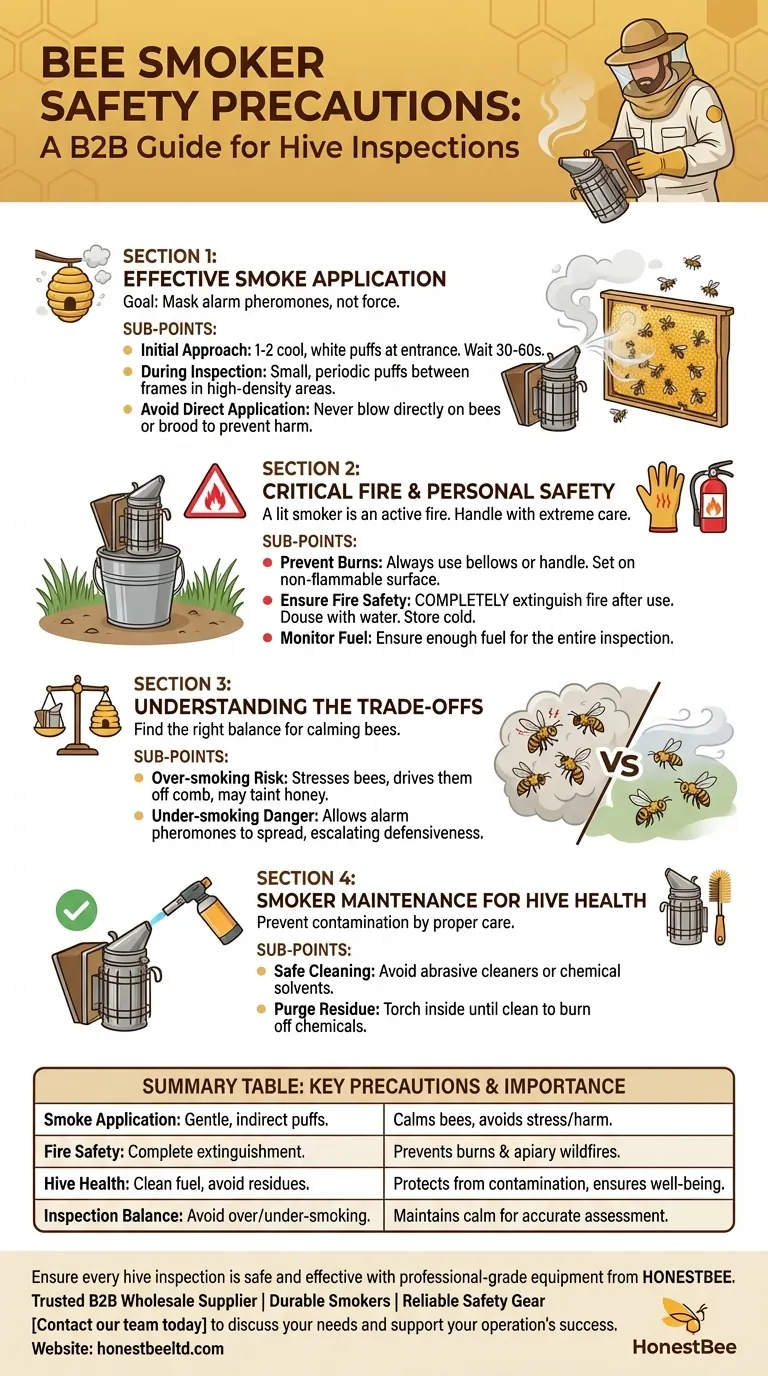Properly using a bee smoker involves three core areas of precaution: effective application to calm the bees, personal and environmental fire safety, and correct handling to prevent harm. The primary goal is to use the smoke sparingly and indirectly to mask alarm pheromones, ensuring a calm inspection without agitating the colony or creating a fire hazard.
The bee smoker is a tool for communication, not force. Its correct use is a delicate balance between calming the hive and minimizing stress, all while rigorously adhering to fire safety protocols.

The Principles of Effective Smoking
Understanding how to apply smoke is the first step in ensuring a safe and productive hive inspection. The goal is to interrupt the bees' defensive communication, not to drive them away with excessive force.
The Initial Approach
Before opening the hive, apply one or two gentle puffs of cool, white smoke into the entrance. This signals your presence and begins to mask the initial alarm pheromones released by guard bees. Wait 30-60 seconds, then apply a few more puffs under the top cover once it is cracked open.
Application During Inspection
As you work through the hive, apply small, periodic puffs of smoke into the gaps between frames. Focus on areas with higher bee density to keep the colony's communication disrupted. Consistent but minimal application is key.
Avoiding Direct Application
Never blow smoke directly onto the bees or the brood. This is overly aggressive, can damage the bees, and may agitate them rather than calm them. The smoke should drift over and around the frames, not be blasted into the colony.
Critical Safety Precautions
A lit smoker is an active fire. Treating it with constant awareness is non-negotiable for the safety of yourself, your bees, and the surrounding environment.
Preventing Burns
The exterior of a smoker becomes extremely hot during use. Always handle it by the bellows or a designated handle. When you need to set it down, place it on a non-flammable surface like bare ground, a rock, or inside a metal bucket, well away from the hive.
Ensuring Fire Safety
This is the most critical precaution. After your inspection is complete, ensure the fire is completely extinguished. Empty the contents onto a fire-proof surface and douse them with water if necessary. Never store a smoker until you are certain it is cold to the touch.
Monitoring Your Fuel
Running out of smoke mid-inspection with a defensive colony can create a difficult and unsafe situation. Always ensure you have enough fuel to last the entire inspection before you begin.
Understanding the Trade-offs
Using a smoker is not without consequences for the hive. The beekeeper's job is to find the right balance.
The Risk of Over-smoking
Using too much smoke is a common mistake. It can cause the bees to become stressed, drive them off the comb (making it hard to find the queen), and lead them to gorge on excessive amounts of honey. In extreme cases, heavy smoke can taint the flavor of honey.
The Danger of Under-smoking
Using too little smoke, or not reapplying it when needed, allows the bees' alarm pheromones to spread. This can quickly escalate a calm inspection into a defensive and chaotic one, increasing the risk of stings and making it difficult to properly assess the hive's health.
Maintaining Your Smoker for Bee Health
The smoker itself can be a source of contamination if not cared for properly.
Choosing Safe Cleaning Methods
Avoid using any abrasive cleaners or chemical solvents to clean your smoker. These products can leave behind toxic residues that are harmful or fatal to your bees when the smoker is next used.
Purging Chemical Residue
If you must use a cleaning product, it is critical to burn off any potential residue afterward. Torch the inside of the smoker until it is clean to ensure no harmful chemicals are introduced into the hive environment during your next inspection.
Applying This to Your Inspections
Your approach should be adapted to the specific temperament of the colony and your environmental conditions.
- If your primary focus is a quick, calm inspection: Use smoke minimally at the entrance and top, only reapplying if you notice the bees' behavior becoming agitated.
- If your primary focus is managing a defensive hive: Be more consistent with your smoke application, using gentle puffs every few minutes to keep alarm pheromones suppressed from the start.
- If your primary focus is fire prevention: Always work with your smoker on a fire-proof surface and have a plan to extinguish it completely before leaving the apiary.
Mastering the smoker is about learning to use it as a tool of respect and clear communication with your colony.
Summary Table:
| Precaution Area | Key Focus | Why It Matters |
|---|---|---|
| Smoke Application | Gentle, indirect puffs; avoid direct contact | Calms bees by masking alarm pheromones without causing stress or harm. |
| Fire Safety | Handle with care; ensure complete extinguishment | Prevents burns and avoids starting a wildfire in the apiary. |
| Hive Health | Use clean fuel; avoid chemical residues | Protects the colony from contamination and ensures bee well-being. |
| Inspection Balance | Avoid over-smoking and under-smoking | Maintains a calm colony for an accurate assessment and minimizes stress. |
Ensure every hive inspection is safe and effective with professional-grade equipment from HONESTBEE.
As a trusted wholesale supplier to commercial apiaries and beekeeping equipment distributors, we provide the durable, reliable smokers and safety gear you need to protect your investment and your bees. Our products are designed for the rigors of commercial use, helping you maintain hive health and maximize productivity.
Contact our team today to discuss your wholesale needs and discover how HONESTBEE can support your operation's success.
Visual Guide

Related Products
- Premium Traditional Copper Bee Smoker with Bellows
- Stainless Steel Honey Bee Smoker Hive and Honeycomb Smoker for Beekeeping
- European Stainless Steel Bee Smoker for Honey Bee Hive
- Electric Bee Smoker European Style Bee Hive Smoker for Beekeeping
- Stainless Steel Electric Beehive Smoker for Beekeeping and Bee Keeper Use
People Also Ask
- How did early beekeepers use bee smokers? Master Ancient Bee Calming Techniques
- What is the purpose of a bee smoker and how should it be used? A Guide to Calm, Safe Hive Inspections
- What is the primary purpose of using smoke in beekeeping? Calm Bees for Safer Hive Management
- What is a Smoker and how is it used in beekeeping? The Essential Tool for Calm, Safe Hive Inspections
- What are some alternatives to using smoke in beekeeping? A Guide to Gentle Hive Management



















